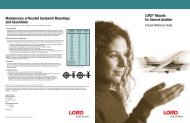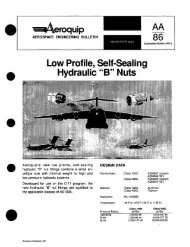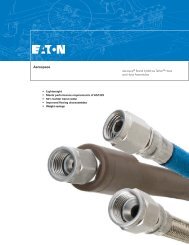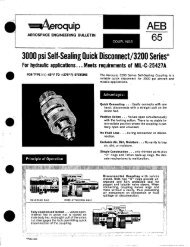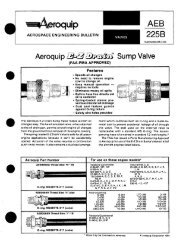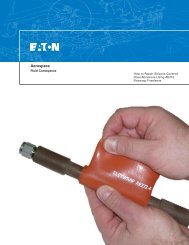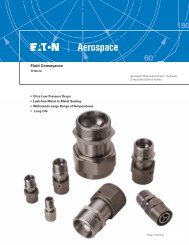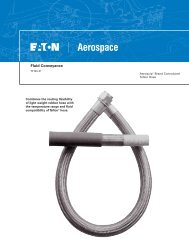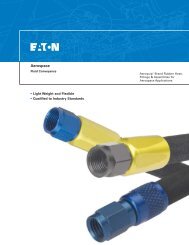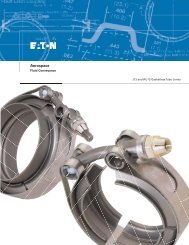Centurion Seal - Herber Aircraft
Centurion Seal - Herber Aircraft
Centurion Seal - Herber Aircraft
Create successful ePaper yourself
Turn your PDF publications into a flip-book with our unique Google optimized e-Paper software.
Aerospace<br />
<strong>Centurion</strong> Brand<br />
Mechanical <strong>Seal</strong>s
Eaton’s <strong>Centurion</strong> Brand Mechanical <strong>Seal</strong>s<br />
The Advantages of Choice<br />
Eaton’s Aerospace Operations<br />
offers the most diverse<br />
line of mechanical seals and<br />
sealing components, including<br />
pressure-balanced face seals,<br />
circumferential segmented<br />
seals, brush seals and welded<br />
metal bellows seals. Each<br />
incorporates the optimum<br />
seal configuration, material<br />
and technology, including<br />
hydrodynamics; which can<br />
be applied to both face and<br />
circumferential seals, significantly<br />
improving performance.<br />
Rather than offer one product,<br />
Eaton possesses hundreds of<br />
solutions to sealing problems.<br />
Eaton can also custom-design<br />
and fabricate exactly what you<br />
need.<br />
The Advantages of Experience<br />
Eaton’s products are installed<br />
on every aircraft in the world,<br />
and on virtually every missile,<br />
satellite, space shuttle, and<br />
weapon system. And we service<br />
our products. Eaton’s <strong>Centurion</strong><br />
brand seals are regularly<br />
repaired and overhauled at<br />
our FAA licensed repair facility<br />
in Warwick, RI (FAA Repair<br />
Station VJPR395K). Airlines<br />
worldwide rely on Eaton to<br />
perform overhaul and repair on<br />
aircraft seals at our FAA repair<br />
station.<br />
Welded metal bellows seals<br />
help to reduce hysteresis and<br />
secondary seal deterioration<br />
in APU compressors, small<br />
gas turbines and fuel controls<br />
while extending the mean<br />
time between overhauls<br />
(MTBO). The welded bellows<br />
secondary seal offers unique,<br />
high value advantages over<br />
conventional elastomeric secondary<br />
seals.<br />
The Advantages of a Strong<br />
Engineering Team<br />
Eaton’s <strong>Centurion</strong> brand Mechanical<br />
<strong>Seal</strong>s are supported<br />
by an Engineering Team,<br />
Metrology Department and a<br />
sophisticated R&D Laboratory.<br />
By leveraging the expertise<br />
of technical teams, Eaton is<br />
capable of supporting customers<br />
in various ways:<br />
• Optimizing seal performance<br />
for specific applications<br />
• Testing seals both statically<br />
and dynamically<br />
• Analyzing customer hardware<br />
and Researching new<br />
seal technologies to en-<br />
hance product capabilities<br />
• Reducing leakage and<br />
extend life<br />
Eaton’s team is dedicated to<br />
not only designing the most<br />
reliable seals for any application,<br />
but also supporting the<br />
products installed over the life<br />
of the application.<br />
<strong>Centurion</strong> brand Segmented Mainshaft<br />
<strong>Seal</strong><br />
Our experience has been<br />
proven in severe applications,<br />
which translates into better<br />
performance. Whether conventional<br />
or complex, <strong>Centurion</strong><br />
brand mechanical seals are<br />
used in auxillary power units<br />
(APUs), compressors, power<br />
generating gas turbines,<br />
aircraft engines, engine starters,<br />
fuel controls, gearboxes,<br />
engine accessories, nuclear<br />
valves, production machinery<br />
equipment, off road vehicles,<br />
and turbochargers at both high<br />
and low speeds, pressures<br />
and temperatures.<br />
A finite element analysis of a circumferential seal and rotor for an aircraft gas turbine application.<br />
2 EATON CORPORATION Aerospace TF100-34 January 2008
700 Series Mechanical <strong>Seal</strong>s<br />
<strong>Centurion</strong> Brand 700 Series<br />
Mechanical <strong>Seal</strong>s<br />
Eaton’s <strong>Centurion</strong> brand 700<br />
Series mechanical seals are<br />
stationary, “face” type seals<br />
designed for a wide array of<br />
applications: from aircraft engine<br />
accessory gearboxes and<br />
mainshafts to hydraulic pumps,<br />
starters, compressors, industrial<br />
generators and other high<br />
speed, rotating machinery.<br />
Although typical designs range<br />
in types managing high speed,<br />
large axial movement or high<br />
pressure applications, there<br />
are mainly two types of 700<br />
Series seals: the monoblock<br />
carbon type and the metalbacked<br />
type (see Figure 1).<br />
Standard sizes exist for shaft<br />
diameters from 0.25” (6 mm)<br />
to 3.0” (75 mm). The monoblock<br />
seal is recommended in<br />
applications where speeds are<br />
high, axial movement is moderate<br />
to high, and pressures are<br />
low. The metal-backed seal is<br />
recommended in high pressure,<br />
low speed applications,<br />
and where axial movement is<br />
moderate.<br />
The <strong>Centurion</strong> brand 700<br />
Series seal can be tailored<br />
to meet specific application<br />
conditions. For example, seals<br />
may accept face or reverse<br />
pressure. They can accomodate<br />
exposure to corrosive<br />
fluid media such as Skydrol.<br />
<strong>Seal</strong>s are “balanced” to handle<br />
high speed or high pressure<br />
applications. The carbon-graphite<br />
sealing element (stator)<br />
is selected as a function of<br />
operating conditions and type<br />
of available lubrication. Under<br />
moderate speed and temperature<br />
conditions, 700 Series<br />
seals can operate satisfactorily<br />
with an oil mist or oil splash<br />
environment. Under some<br />
operating conditions, seals<br />
can be configured to operate<br />
dry-running, i.e., with minimal<br />
oil mist, spray or jet, with the<br />
proper selection of interfacing<br />
materials, design and seal<br />
balance.<br />
<strong>Centurion</strong> brand 700 Series Mechanical <strong>Seal</strong>s cross-section (monoblock and metal<br />
backed versions)<br />
700 Series <strong>Seal</strong> Performance<br />
700 SERIES SEAL<br />
Size (English)<br />
Size (Metric)<br />
Speed (English)<br />
Speed (Metric)<br />
Pressure (English)<br />
Pressure (Metric)<br />
Temperature (English)<br />
Temperature (Metric)<br />
Leakage (English)<br />
Leakage (Metric)<br />
Life<br />
Comments<br />
UNBALANCED<br />
FACE<br />
0.375” to 12.0”<br />
10 to 300 mm<br />
300 feet /<br />
second*<br />
100 m/s*<br />
150 PSID*<br />
10 bar*<br />
-65 to 350°F<br />
-50 to 175°C<br />
0.05 to 0.15 cu<br />
in/hr<br />
1 to 3 cc/hour<br />
10,000 hours**<br />
BALANCED<br />
FACE<br />
0.375” to 12.0”<br />
10 to 300 mm<br />
300 feet /<br />
second*<br />
100 m/s*<br />
375 PSID*<br />
25 bar*<br />
-65 to 350°F<br />
-50 to 175°C<br />
0.05 to 0.15 cu<br />
in/hr<br />
1 to 3 cc/hour<br />
10,000 hours**<br />
<strong>Centurion</strong> brand 700 Series <strong>Seal</strong><br />
(monoblock version)<br />
SPECIAL<br />
DESIGN<br />
0.375” to 12.0”<br />
10 to 300 mm<br />
300 feet /<br />
second*<br />
100 m/s*<br />
1500 PSID*<br />
100 bar*<br />
-65 to 350°F<br />
-50 to 175°C<br />
Negligible<br />
Negligible<br />
15,000 hours**<br />
Special designs include hydrodynamic seals. By incorporating hydrodynamic<br />
technology into face seals a step change in life and performance can be<br />
realized. Hydrodynamic seals (which are non-contacting) ride on film of air<br />
therefore heat generation is essentially eliminated. The result is a seal that<br />
can survive or even thrive at conditions typically well beyond those of typical<br />
contact seals.<br />
* Not simultaneously<br />
** <strong>Seal</strong> Life is a function of operating parameters. The life provided herein is for reference only. For specific applications<br />
consult with Eaton Engineering.<br />
EATON CORPORATION Aerospace TF100-34 January 2008<br />
3
Mating Rings For Face-Type <strong>Seal</strong>s & Runners For Circumferential <strong>Seal</strong>s<br />
Face-Type <strong>Seal</strong>s for Large Engine Mainshafts<br />
<strong>Centurion</strong> Brand Mating<br />
Rings for Face-Type <strong>Seal</strong>s<br />
and Runners for<br />
Circumferential <strong>Seal</strong>s<br />
Mating Ring<br />
Good seal performance is provided<br />
by a properly configured<br />
stator (seal) mated to a high<br />
quality, tightly toleranced rotor<br />
(mating ring or runner). Therefore,<br />
Eaton’s <strong>Centurion</strong> brand<br />
seals should be accompanied<br />
by mating rings or rotors<br />
designed and fabricated by<br />
Eaton. Like the carbon-graphite<br />
seal face in our face seals,<br />
the associated mating ring<br />
must be extremely flat (typically<br />
2 to 3 Helium light bands<br />
or 0.000022 to 0.000033<br />
inches—0.6 to 0.9 mm) and<br />
possess a smooth finish (4 Ra<br />
- 0.1 micrometers).<br />
Mating rings must be retained<br />
on a shaft in a manner that<br />
prevents slippage, leakage,<br />
and distortion. It must also be<br />
properly aligned with sources<br />
of lubrication, and are often<br />
“balanced.” Likewise, circumferential<br />
seal rotors must be<br />
round, smooth and balanced.<br />
They can be optimized to<br />
minimize coning, and in<br />
some cases may require spin<br />
testing. Some rotors require<br />
hydrostatic or hydrodynamic<br />
geometry to either aid in lifting<br />
off or suctioning down its seal<br />
ring.<br />
Hydrodynamic Mating Ring<br />
Materials for rotors must have<br />
excellent thermal conductivity<br />
and surface hardness. In<br />
some cases coatings may be<br />
required. Understanding operating<br />
parameters for the seal<br />
and mating ring set will allow<br />
the designer to tailor a solution<br />
with the proper design, materials,<br />
and coatings.<br />
<strong>Centurion</strong> Brand Face-Type<br />
<strong>Seal</strong>s for Large Engine<br />
Mainshafts<br />
<strong>Centurion</strong> brand Face-Type <strong>Seal</strong> for<br />
Large Engine Mainshafts<br />
Face-type seals used on large<br />
engine mainshafts are similar<br />
in construction to conventional<br />
700 class seals, but have additional<br />
characteristics to handle<br />
the surface speeds, temperatures<br />
and pressures typically<br />
required of such applications.<br />
The carbon seal ring stator is<br />
housed into a metal carrier<br />
and is spring loaded against<br />
the mating ring (rotor) by a<br />
series of coil springs. Due<br />
to the temperature requirements,<br />
elastomers are not<br />
used. Instead, the secondary<br />
seal is one or two piston rings<br />
comprised of metal, carbon<br />
graphite, or a Teflon ® jacketed<br />
spring seal. Such large<br />
diameter face seals are usually<br />
required to seal high temperature<br />
air. At high speeds<br />
and pressures, some seals<br />
are configured to introduce oil<br />
lubrication directly at the interface,<br />
and are achieved by a<br />
flow of oil introduced through<br />
the mating ring. The oil dissipates<br />
heat and introduces<br />
lubrication at the interface.<br />
These seals are referred to as<br />
Face-Type <strong>Seal</strong>s for Engine<br />
Mainshafts Performance<br />
Size (English)<br />
Size (Metric)<br />
Speed (English)<br />
Speed (Metric)<br />
Pressure (English)<br />
Pressure (Metric)<br />
Temperature (English)<br />
Temperature (Metric)<br />
Leakage (English)<br />
Leakage (Metric)<br />
Life<br />
Comments<br />
a “wet” face configuration.<br />
Eaton’s <strong>Centurion</strong> brand facetype<br />
seals are used to protect<br />
bearing sumps from hot gases<br />
at elevated pressure when<br />
conventional buffered labyrinth<br />
seals either take up too<br />
much axial and radial space in<br />
the design of the gas turbine<br />
mainshaft, are too heavy, or<br />
are insufficient to manage the<br />
required controlled leakage.<br />
4” to 20”<br />
100 to 500 mm<br />
400 feet /<br />
second<br />
120 m/s<br />
150 PSID<br />
10 bar<br />
800°F<br />
425°C<br />
800 Series Mechanical <strong>Seal</strong>s<br />
<strong>Centurion</strong> 800 Series<br />
Mechanical <strong>Seal</strong>s<br />
Eaton’s <strong>Centurion</strong> brand 800<br />
Series mechanical seals are<br />
stationary, “face” type seal<br />
with an all-metallic construction.<br />
Originally designed<br />
for extreme environmental<br />
applications, the 800 Series<br />
has found its way into a wide<br />
array of applications: from fuel<br />
controls, auxillary power units<br />
and small aircraft engine gas<br />
turbine mainshafts, to helicopter<br />
gearboxes, to crygenic<br />
turbopumps and nuclear valves<br />
and systems.<br />
The 800 Series welded metal<br />
bellows seal shown is comprised<br />
of a carbon-graphitesealing<br />
element held in a<br />
low-expansion alloy carrier. The<br />
carrier is welded to a series of<br />
alternating welded stamped<br />
diaphragms, which perform<br />
as both a hermetic secondary<br />
seal and a spring for the<br />
mechanical seal. The effective<br />
diameter of the bellows acts<br />
as the seal’s balance diameter.<br />
The bellows produce a<br />
low spring rate and allow the<br />
seal to operate over a long<br />
axial operating length while<br />
producing a very controlled<br />
mechanical load. For seals<br />
required to function in applications<br />
of high pressure, bellows<br />
plates can be configured to<br />
control effective diameter (ED)<br />
shift, controlling pneumatic<br />
loads produced on the sealing<br />
interface.<br />
Considerations are made for<br />
system vibration in bellows design.<br />
The loading provided by<br />
the bellows can be precisely<br />
controlled in a manner which<br />
produces a low hysteresis<br />
— lower than most springloaded<br />
mechanical seals. In applications<br />
with high runout, the<br />
800 Series seal face (stator)<br />
tracks its mating ring (rotor)<br />
well, maintaining contact and<br />
preventing leakage. In conventional<br />
seals, higher hysteresis<br />
(accompanied by high stator<br />
mass) tends to prevent appropriate<br />
contact of stator in rotor<br />
under such severe conditions.<br />
Bellows seals can be constructed<br />
from any weldable<br />
material, and can therefore be<br />
designed for compatibility with<br />
virtually any media. The most<br />
popular materials for welded<br />
metal bellows seals include:<br />
AISI 316L, 347, precipitation<br />
hardenable materials such as<br />
AM350, AM350 SCT, Titanium,<br />
high nickel alloys such as<br />
Inconel 718, Inconel X750, and<br />
Hastelloys. Due to its all-metallic<br />
construction, the 800 Series<br />
seal is perfect for applications<br />
requiring tightly controlled<br />
loads to manage heat generation<br />
or in highly caustic fluid<br />
media conditions.<br />
800 Series <strong>Seal</strong> Performance<br />
Size (English)<br />
Size (Metric)<br />
Speed (English)<br />
Speed (Metric)<br />
Pressure (English)<br />
Pressure (Metric)<br />
Temperature (English)<br />
Temperature (Metric)<br />
Leakage (English)<br />
Life<br />
Comments<br />
0.375” to 10.0”<br />
10 to 250 mm<br />
400 feet/second*<br />
140 m/s*<br />
375 PSID<br />
25 bar*<br />
-400 to 1100°F*<br />
-250 to +600°C*<br />
Negligible<br />
20,000 hours**<br />
Applications with high differential<br />
pressure may require<br />
special plate configurations<br />
and/or 2-ply bellows configurations.<br />
<strong>Seal</strong> is temperature<br />
limited solely by the carbon<br />
graphite sealing element.<br />
Consult with Eaton Engineering.<br />
* Not simultaneously<br />
**<strong>Seal</strong> Life is a function of operating parameters. The life provided herein is for<br />
reference only. For specific applications consult with Eaton Engineering.<br />
EATON CORPORATION Aerospace TF100-34 January 2008<br />
5
1200 Series Circumferential Segmented <strong>Seal</strong>s<br />
<strong>Centurion</strong> Brand 1200 Series<br />
Circumferential Segmented<br />
<strong>Seal</strong>s<br />
In addition to face type seals<br />
as previously described, many<br />
aircraft and industrial gas<br />
turbines apply circumferential<br />
segmented seals in severe<br />
environment applications<br />
requiring high reliability and<br />
long life in. Segmented carbon<br />
seals are also used as barrier<br />
seals in industrial compressors.<br />
Such seals are ideal in<br />
applications where long axial<br />
movements are anticipated<br />
due to thermal or mechanical<br />
phenomena usually found in<br />
today’s rotor-machinery systems.<br />
Typical sizes range from<br />
shaft diameters of 1.6” (4 mm)<br />
to 10.0” (250 mm).<br />
Circumferential segmented<br />
seals are comprised of a<br />
series of segmented carbon<br />
rings, which are configured<br />
to contact the shaft or runner<br />
(rotor). These segments are<br />
contained within a seal housing,<br />
then locked into position<br />
with anti-rotation keys or pins.<br />
A secondary seal is formed by<br />
the axial spring loading of the<br />
seal rings against the finely<br />
machined intermal surface of<br />
the housing. A garter spring<br />
contains the segments together<br />
and applies the circumferential<br />
load at the dynamic<br />
sealing interface. A unique<br />
joint configuration at each end<br />
of the segments results in a<br />
minimal leakage at each joint.<br />
The segments are pressure relieved<br />
to control actual contact<br />
loads, both axially and radially,<br />
and are configured so that<br />
during transient movement,<br />
a continuous sealing dam is<br />
always in contact with either<br />
the primary or secondary sealing<br />
surfaces.<br />
other liquid. In the presence<br />
of a liquid, seal ring segments<br />
are subject to lift open due<br />
to viscous effects, unless a<br />
special design is applied which<br />
would allow the seal ring segments<br />
to close the seal at its<br />
interface using such features<br />
as hydrodynamic geometry.<br />
As most circumferential-segmented<br />
seals are contacting<br />
seals, the frictional heat generated<br />
by the runner and carbon<br />
at high sliding speeds must<br />
be dissipated by an appropriate<br />
cooling method. The usual<br />
methods involve directing a<br />
flow of oil at, on or under the<br />
runner.<br />
The most common application<br />
for Eaton’s <strong>Centurion</strong><br />
brand 1200 Series seals are<br />
as mainshaft seals for stateof-the-art<br />
aircraft gas turbine<br />
engines, but other applications<br />
include compressor barrier<br />
seals (which act as a backup<br />
to high pressure, non-contacting<br />
gas seals) used in modern<br />
compressors, and in blowers,<br />
mixers and separators. <strong>Aircraft</strong><br />
seals occasionally require<br />
such design enhancements as<br />
housing windbacks, a screwlike<br />
visco seal which restricts<br />
oil at the primary sealing<br />
interface; windage screens,<br />
which attempt to keep oil<br />
to the outside and air to the<br />
inside of the sealing system;<br />
and choppers, which fling oil<br />
to the outside surfaces away<br />
from the sealing interface.<br />
1200 Series <strong>Seal</strong> Performance<br />
CENTURION BRAND<br />
1200 SERIES<br />
SEGMENTED SEAL<br />
Size (English)<br />
Size (Metric)<br />
Speed (English)<br />
Speed (Metric)<br />
Pressure (English)<br />
Pressure (Metric)<br />
Temperature (English)<br />
Temperature (Metric)<br />
Leakage (English)<br />
Leakage (Metric)<br />
Life<br />
Comments<br />
CONTACTING<br />
CIRCUMFERENTIAL<br />
SEGMENTED SEAL<br />
1.6” to 10.0”<br />
40 to 250 mm<br />
400 feet / second<br />
120 m/s<br />
90 PSID<br />
6 bar<br />
-65 to 950°F<br />
-50 to 500°C<br />
Consult with Eaton<br />
Engineering<br />
Consult with Eaton<br />
Engineering<br />
>8000 hours*<br />
ARCH-BOUND<br />
CIRCUMFERENTIAL<br />
SEGMENTED SEAL<br />
0.375” to 12.0”<br />
40 to 125 mm<br />
800 feet /<br />
second<br />
240 m/s<br />
90 PSID<br />
6 bar<br />
-65 to 900°F<br />
-50 to 500°C<br />
Consult with Eaton<br />
Engineering<br />
Consult with Eaton<br />
Engineering<br />
>8000 hours*<br />
Hydrodynamic technology can be incorporated into<br />
welded metal bellows face seals. By incorporating<br />
hydrodynamics a step change in life and performance<br />
can be realized. Hydrodynamic seals (which are noncontacting)<br />
ride on film of air therefore heat generation<br />
is essentially eliminated. The result is a seal that can<br />
survive or even thrive at conditions typically well beyond<br />
those of typical contact seals.<br />
*<strong>Seal</strong> Life is a function of operating parameters. The life provided herein is for reference<br />
only. For specific applications consult with Eaton Engineering.<br />
Circumferential seals are<br />
designed for sealing gases,<br />
and are often designed in a<br />
gas buffered tandem arrangement<br />
when sealing an oil or<br />
6 EATON CORPORATION Aerospace TF100-34 January 2008
1900 Series Brush <strong>Seal</strong>s<br />
1300 Series Clearance <strong>Seal</strong>s<br />
Eaton <strong>Centurion</strong> 1900 Series<br />
Brush <strong>Seal</strong>s<br />
Brush seals made of high<br />
temperature nickel-cobalt alloy<br />
bristles are circumferential<br />
seals which may be used in<br />
place of traditional labyrinth<br />
seals in large or small gas<br />
turbine secondary and tertiary<br />
flow gas paths. Low-hysteresis<br />
damping plates allow<br />
seals to withstand large radial<br />
movements without opening,<br />
allowing the seals to manage<br />
high temperature, high-speed<br />
environments with long life<br />
capabilities.<br />
Brush seals are comprised of<br />
an array of densely packed,<br />
high temperature resistant,<br />
low wear bristles, configured<br />
on an angle of approximately<br />
45 degrees with the tangent of<br />
its adjacent shaft. The bristles<br />
form a flexible porous medium,<br />
controlling leakage from 1/5<br />
to 1/3 of typical labyrinth seal<br />
leakage. The seal takes up<br />
slightly more radial room than<br />
a conventional straight toothed<br />
labyrinth, but takes up significantly<br />
less axial space, and<br />
weighs far less than machine<br />
labyrinths.<br />
Brush seals are being applied<br />
in today’s gas turbines as replacement<br />
for labyrinth, other<br />
air to air seals and oil seals<br />
to improve engine efficiency,<br />
reduce fuel consumption and<br />
increase engine thrust.<br />
Eaton <strong>Centurion</strong> 1300 Series<br />
Clearance <strong>Seal</strong>s<br />
Clearance seals are circumferential<br />
non-contacting seals,<br />
which are free to move radially<br />
to track transient excursions<br />
over the shaft to which it is<br />
applied. Much like the 1200<br />
Series seal, this circumferential<br />
seal also uses a precision<br />
machined housing which,<br />
when interfacing with the<br />
seal ring, acts as a secondary<br />
sealing element. The clearance<br />
seal is ideal for applications<br />
with large axial and small radial<br />
movements.<br />
The primary seal ring is comprised<br />
of a high temperature<br />
carbon-graphite, pressed and<br />
stabilized into a metal band or<br />
carrier. The resulting assembly<br />
is called a “composite.”<br />
The band of the composite is<br />
selected to match the coefficient<br />
of thermal expansion<br />
of the shaft, and by doing<br />
so controls leakage through<br />
the seal over most operating<br />
conditions. The seal ring is<br />
designed for a very small, controlled<br />
clearance, producing a<br />
controlled but acceptable leakage<br />
between the seal’s tightly<br />
toleranced inside diameter,<br />
and the diameter of the runner<br />
or shaft. The composite hunts<br />
for a steady state position during<br />
shaft excursions.<br />
Since clearance seals are noncontacting,<br />
they can withstand<br />
high surface speeds; and since<br />
they are made of metal and<br />
carbon-graphite, the temperature<br />
limitation on the seal<br />
is dictated by the materials<br />
selected.<br />
Clearance seals are superior<br />
to labyrinth seals since they<br />
allow more seal flexibility, and<br />
their design allows the seal<br />
to accomodate larger radial<br />
movements without seal degradation.<br />
Leakages are usually<br />
an order of magnitude lower<br />
than labyrinth seals. They<br />
are excellent for sealing hot<br />
gases from bearings and other<br />
critical components in rotating<br />
equipment.<br />
The envelope required is<br />
small, compact and low on<br />
mass. Clearance seals are<br />
used adjacent to turbine and<br />
compressor bearings in small<br />
gas turbines and power units,<br />
as well as buffered low temperature<br />
applications such as<br />
one for a LOX turbopump.<br />
1900 Series Brush <strong>Seal</strong>s Performance<br />
Size (English)<br />
Size (Metric)<br />
Speed (English)<br />
Speed (Metric)<br />
Pressure (English)<br />
Pressure (Metric)<br />
Temperature (English)<br />
Temperature (Metric)<br />
Leakage (English)<br />
Leakage (Metric)<br />
Life*<br />
1.6” to 60”<br />
40 mm to 1.5 M<br />
1200 feet / second<br />
365 m/s<br />
Up to 300 PSID per stage<br />
Up to 20 bar per stage<br />
1200°F<br />
650°C<br />
Consult with Eaton Engineering<br />
Consult with Eaton Engineering<br />
Consult with Eaton Engineering<br />
*<strong>Seal</strong> Life is a function of operating parameters. The life provided herein is for<br />
reference only. For specific applications consult with Eaton Engineering.<br />
1300 Series Clearance <strong>Seal</strong> Performance<br />
Size (English)<br />
Size (Metric)<br />
Speed (English)<br />
Speed (Metric)<br />
Pressure (English)<br />
Pressure (Metric)<br />
Temperature (English)<br />
Temperature (Metric)<br />
Leakage (English)<br />
Leakage (Metric)<br />
Life<br />
0.375” to 6.0”<br />
10 to 150 mm<br />
800 feet/second<br />
240 m/s<br />
90 PSID<br />
6 bar<br />
-400 to 1200°F<br />
-250 to 650°C<br />
Consult with Eaton Engineering<br />
Consult with Eaton Engineering<br />
>8000 hours*<br />
*<strong>Seal</strong> Life is a function of operating parameters. The life provided herein is for reference<br />
only. For specific applications consult with Eaton Engineering.<br />
EATON CORPORATION Aerospace TF100-34 January 2008<br />
7
Eaton Corporation<br />
Conveyance Systems Division<br />
300 South East Avenue<br />
Jackson, Michigan 49203-1972<br />
Phone: (517) 787-8121<br />
Fax: (517) 787-5758<br />
Eaton Corporation<br />
Conveyance Systems Division<br />
Route 2 Box 361<br />
Meadowbrook Road<br />
Eastanollee, Georgia 30538<br />
Phone: (706) 779-3351<br />
Fax: (706) 779-2638<br />
Eaton Corporation<br />
Conveyance Systems Division<br />
11642 Old Baltimore Pike<br />
Beltsville, Maryland 20705<br />
Phone: (301) 937-4010<br />
Eaton Corporation<br />
Conveyance Systems Division<br />
15 Pioneer Ave.<br />
Warwick, Rhode Island 02888<br />
Phone: (401) 781-4700<br />
Fax: (401) 461-4310<br />
Eaton Corporation<br />
Conveyance Systems Division<br />
671 W. 17th Street<br />
Costa Mesa, California 92627<br />
Phone: (949) 548-3421<br />
Fax: (949) 752-2997<br />
Eaton LTD<br />
Conveyance Systems Division<br />
Broad Ground Road<br />
Lakeside<br />
Redditch<br />
Worcs B98 8YS<br />
England<br />
Phone: (44) 152-751-7555<br />
Fax: (44) 152-751-7556<br />
Eaton S.A.<br />
Conveyance Systems Division<br />
2 Rue Lavoisier BP 54 78310<br />
Coignieres, France<br />
Phone: (33) 1-30-69-3000<br />
Eaton LTD<br />
Conveyance Systems Division<br />
Chemin De Pau<br />
64121 Serres-Castet<br />
France<br />
Phone: (33) 559-333-864<br />
Fax: (33) 559-333-865<br />
Eaton LTD<br />
Conveyance Systems Division<br />
Posttach 1026<br />
Carl -Benz-Strasse 9<br />
D-82205 Gilching<br />
Germany<br />
Phone: 49 (0) 8105-750<br />
Fax: 49 (0) 8105-7555<br />
Vickers Systems Pte Ltd<br />
Conveyance Systems Division<br />
Lot 512, Jalan Delima, Batamindo<br />
Industrial Park<br />
Batam 29433, Indonesia<br />
Phone: (62) 611823<br />
© 2008 Eaton Corporation<br />
All Rights Reserved<br />
Printed in USA<br />
Copying or Editing is Forbidden<br />
Form No. TF100-34<br />
January 2008



